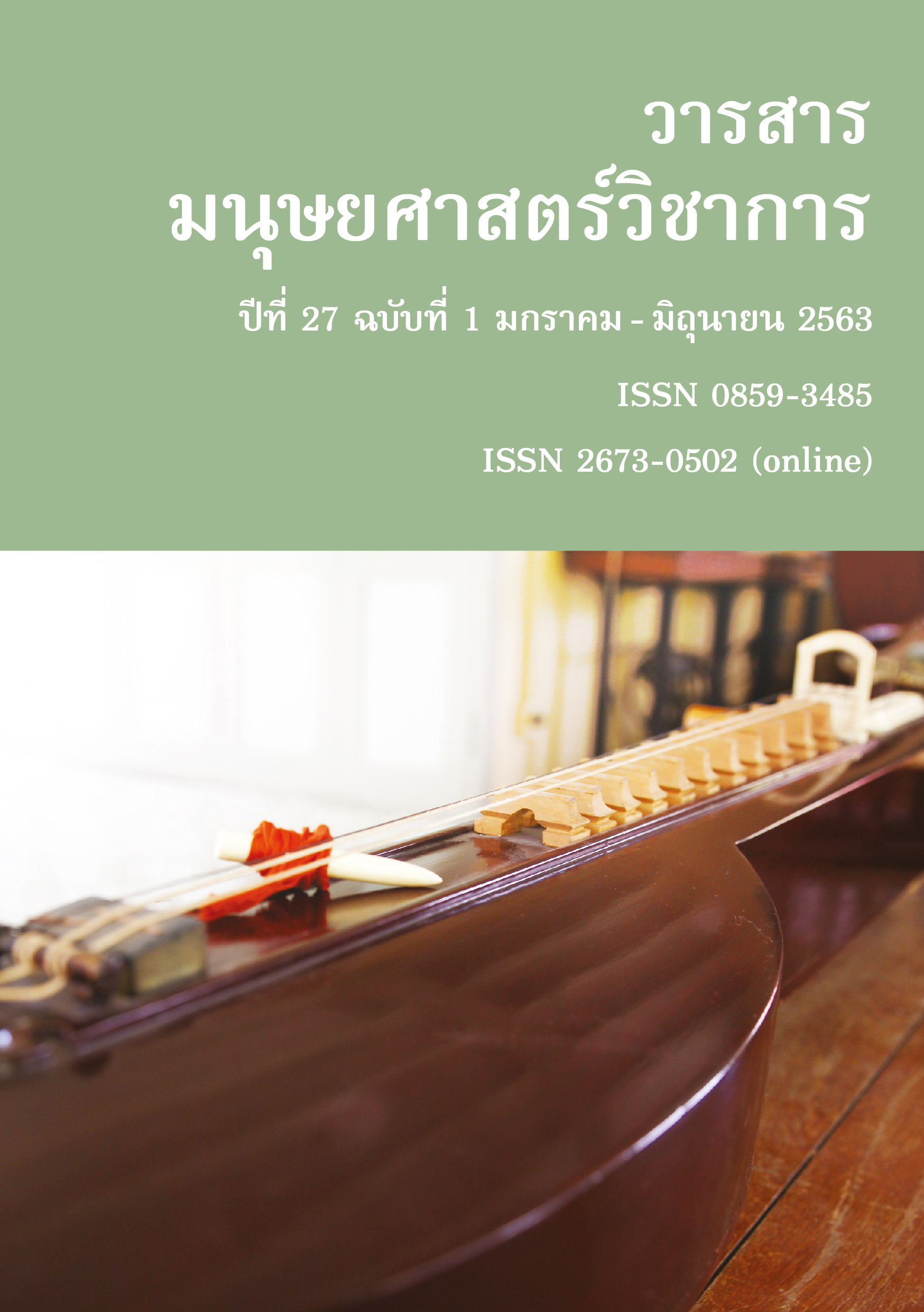The Study of Local Healthy Food from Identity of Community-based Tourism for Health Tourism Destinations in Western Thailand Nongrong Community, Nongrong Sub-district, Phanom Tuan District, Kanchanaburi Province
Main Article Content
Abstract
Abstract
This research aimed to: 1) study the community context in community-based tourism at Nongrong Subdistrict; 2) study the local healthy food in Nongrong community and; 3) invent the stories and cooking lesson in local healthy food based on Nongrong community identity. A qualitative method and participatory action research were used by the research team and local people to develop guidelines for promoting community-based tourism development through food story. Additionally, it provided job opportunities to local communities, toward local experiential and health tourism.
The research result were: 1) the identity of Nongrong Community in Kanchanaburi Province was community-based tourism. Ban Huay Sapan Samakkee Community Forest was the starting point of community tourism at Ban Huay Sapan. There were 21 community tourism destination. Local food resources were applied in tourism activities. The local vegetable ingredients, for example, were bamboo shoot, horse radish tree, banana blossom, Thai yellow eggplants, wood apple, hog plum leaves, and sand ginger leaves. These ingredients were identity of Nongrong Community. The research result from in-depth interviewed and focus-group discussion about local food data of Nongrong Community showed 41 local recipes. Most of them were curries without coconut milk. Fishes and chickens were main meat in the recipe. Vegetables and herbs were main ingredients. It is because Nongrong geographical feature was flat plain with small hills where food resources were available for variety of menu. 2) The results also showed that most of the foods were defined as local dishes and are well-known for more than 10 years. 70 percent of ingredients were locally available. Therefore, it was easy for applying cooking to a tourism activity. 3) There were 6 set of local healthy menu for creating stories based on history, background and way of life in Nongrong Community. Lessons in local cooking, Thai cuisine, herbal usage and local wise wisdom were developed as a tourist activity in Nongrong community-based tourism.
Article Details
References
กระทรวงการท่องเที่ยวและกีฬา. (2554). ยุทธศาสตร์กระทรวงการท่องเที่ยวและกีฬา พ.ศ.2555-2559.
https://www.mots.go.th/ewt_dl_link.php?nid=7100
เกศศิณี ตระกูลทิวากร. (2557). รายงานการวิจัยเรื่องการส่งเสริมการท่องเที่ยวโดยใช้ภาพลักษณ์ของอาหารท้องถิ่น. กรุงเทพ: สำนักงานกองทุนสนับสนุนการวิจัย.
พรศักดิ์ พรหมแก้ว. (2550). อาหารภาคใต้. ใน การประชุมโครงการสัมมนาดุสิตาวิชาการครั้งที่ 2 เฉลิมพระเกียรติฯ เนื่องในโอกาสมหามงคลเฉลิมพระชนมพรรษา 80 พรรษา, ความหลากหลายทางวัฒนธรรมอาหารไทยในยุคโลกาภิวัตน์. กรุงเทพฯ: สถาบัน ภาษา ศิลปะ และวัฒนธรรม มหาวิทยาลัยราชภัฏสวนดุสิต.
พลอยระดา ภูมี และปิยะนุช โทมล. (2560). ความหลากหลายและการใช้ประโยชน์ของพืชอาหารป่าในตลาดพื้นบ้านอีสาน กรณีีศึึกษาพื้นที่ลุ่มน้ำห้วยหลวง ภาคตะวัันออกเฉีียงเหนืือ ประเทศไทย.วารสารพื้นถิ่นโขง ชีี มููล, 3(1), 187-210.
เพ็ญนภา ทรัพย์เจริญ. (2540). อาหารพื้นบ้าน 4 ภาค. กรุงเทพฯ: สถาบันการแพทย์แผนไทย กรมการแพทย์ กระทรวงสาธารณสุข.
รวีโรจน์ อนันตธนาชัย. (2548). อาหารไทย:อาหารสมดุล - สมุนไพร. กรุงเทพฯ: เสมาธรรม.
วารุณี วารัญญานนท์, ณรงค์ สมพงษ์, สุรชัย จิวเจริญสกุล และณัฐพล รำไพ (2557). รายงานการวิจัยฉบัยสมบูรณ์เรื่องการจัดการความรู้อาหารไทยท้องถิ่นบนเส้นทางการท่องเที่ยวภาคเหนือ. กรุงเทพฯ: สำนักงานคณะกรรมการวิจัยแห่งชาติและสำงานกองทุนสนับสนุนการวิจัย.
วุฒิชาติ สุนทรสมัย และ ปิยะพร ธรรมชาติ. (2559). รูปแบบการท่องเที่ยวชุมชนเชิงสุขภาพของจังหวัดปราจีนบุุรีี เพื่อการพััฒนาเครือข่ายวิสาหกิจชุุมชนอย่างยั่งยืน. วารสารสมาคมนักวิจัย, 21(3), 167-181.
ศูนย์ข้อมูลความรู้ประชาคมอาเซียน. (2555, 20 ตุลาคม). การบริการท่องเที่ยวไทยภายใต้กรอบ AEC ประชาคมเศรษฐกิจอาเซียน. สืบค้นเมื่อ 15 สิงหาคม 2560 จาก http://www.thai-aec.com/115#ixzz23gwp3FVz.
สริตา พันธ์เทียน, ทรงคุณ จันทจร และมาริสา โกเศยะโยธิน. (2560). รูปแบบการจัดการท่องเที่ยวเชิงอาหารไทยโดยใช้แนวคิดเศรษฐกิจสร้างสรรค์ในเขตจังหวัดลุ่มแม่น้ำภาคกลาง. วารสารวิิจััยและพััฒนา ฉบัับมนุษยศาสตร์และสังคมศาสตร์ มหาวิิทยาลััยราชภััฏสวนสุุนัันทา, 9(3), 190-198.
สำนักงานพัฒนาเศรษฐกิจจากฐานชีวภาพ. (2556). สารานุกรมความหลากหลายทางชีวภาพและภูมิปัญญา ตำบลหนองโรง. นนทบุรี: ดีดี มีเดีย พลัส.
สำนักงานสถิติแห่งชาติ กระทรวงเทคโนโลยีสารสนเทศและการสื่อสาร. (2555). ประมวลสถิติสำคัญของประเทศไทย พ.ศ. 2555. สํานักสถิติพยากรณ์ สํานักงานสถิติแห่งชาติ. กรุงเทพฯ.
โสรัจจ์ วิสุทธิแพทย์. (2557). ภูมิปัญญาอาหารท้องถิ่น: การจัดการเพื่อส่งเสริมการท่องเที่ยวในภาคตะวันออก (ปรัชญาดุษฎีบัณฑิต สาขาวิชาวัฒนธรรมศาสตร์) มหาวิทยาลัยมหาสารคาม, มหาสารคาม.
อำไพ พฤติวงพงศ์กุล. (2551). อาหารพื้นบ้านไทย. ใน ตำราวิชาการอาหารเพื่อสุขภาพ. กรงุ เทพฯ: กองการแพทย์ทางเลือก กรมพฒันาการแพทย์แผนไทยและการแพทย์ทางเลือก.
Fields, K. (2002). Demand for the gastronomy tourism product: motivational factors. In A.-M. a. G. R. Hjalager (Eds.), Tourism and gastronomy (pp. 36-50). London: Routledge.
Hjlalger, A-M. and Corigliano, M.A. (2000). Food for tourists- Determinants of an image. International Journal of Tourism Research, 2(4), 281-293.
Kim, Y. G., Eves, A., & Scarles, C. (2009). Building a Model of Local Food Consumption on Trips and Holidays: A Grounded Theory Approach. International Journal of Hospitality Management. 28(3), 423-431.


